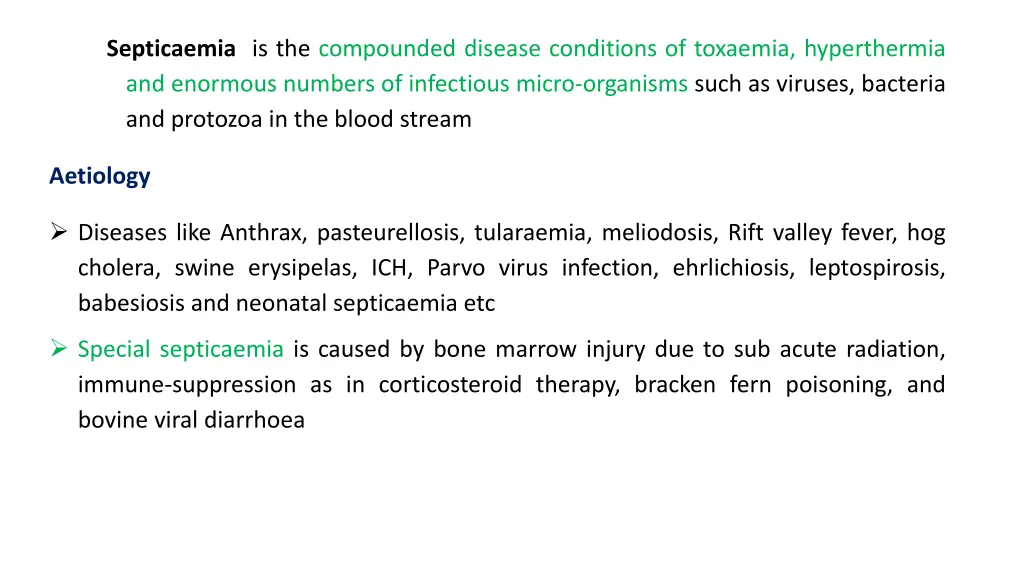
Septicaemia and its Causes, Symptoms, and Diagnosis
Septicaemia is a serious condition caused by infectious micro-organisms in the bloodstream, leading to toxaemia, hyperthermia, and other complications. Learn about its causes, symptoms, pathogenesis, clinical signs, and diagnosis in animals.
Download Presentation

Please find below an Image/Link to download the presentation.
The content on the website is provided AS IS for your information and personal use only. It may not be sold, licensed, or shared on other websites without obtaining consent from the author. If you encounter any issues during the download, it is possible that the publisher has removed the file from their server.
You are allowed to download the files provided on this website for personal or commercial use, subject to the condition that they are used lawfully. All files are the property of their respective owners.
The content on the website is provided AS IS for your information and personal use only. It may not be sold, licensed, or shared on other websites without obtaining consent from the author.
E N D
Presentation Transcript
Septicaemia is the compounded disease conditions of toxaemia, hyperthermia and enormous numbers of infectious micro-organisms such as viruses, bacteria and protozoa in the blood stream Aetiology Diseases like Anthrax, pasteurellosis, tularaemia, meliodosis, Rift valley fever, hog cholera, swine erysipelas, ICH, Parvo virus infection, ehrlichiosis, leptospirosis, babesiosis and neonatal septicaemia etc Special septicaemia is caused by bone marrow injury due to sub acute radiation, immune-suppression as in corticosteroid therapy, bracken fern poisoning, and bovine viral diarrhoea
Pathogenesis There are two concepts that operate in genesis of septicaemia Exotoxins or endotoxins produced by infectious agents results in severe toxaemia and high fever because of their rapid multiplication and spread to all over the body Further localisation of these toxins in particular organs produces serious defects in the surviving animals Toxins also cause direct damage to endothelium epithelium resulting in haemorrhages into tissues The same principle is applicable to viraemia except that viruses donot produce toxins It is thought that general clinical signs are caused by killed body cells by the multiplication of virus
In some of the septicaemic diseases that cause death due to disseminated intravascular coagulation (DIC) DIC is initiated by intravascular trauma or injury with partial damage to the intima caused by circulating foreign materials like antigen-antibody complex, endotoxins and bacterial cell wall with subsequent platelet aggregation and formation of thrombi Clinical signs Clinicals signs include fever and submucosal and sub-epidemal haemorrhages which are petechial or occasionally ecchymotic The haemorrhages mostly can be seen under the conjunctiva, and in mucosa of mouth and vulva Besides, localised signs may occur in joints, heart valves, meninges, eyes and other organs due to localisation of infectious agents. Necropsy findings Sub serosal and submucosal haemorrhages, emboli of infectious agents in various organs in addition to specific lesions of the causative agents
Diagnosis Based on history and clinical signs of presence of petechial haemorrhage in mucosa and conjunctivae Confirmatory diagnosis based on the isolation and identification of causative agents from blood stream at the stage of high rise of temperature Haematology: leukopenia or leukocytosis (bacterial/viral), consumption coagulopathy is usually diagnosed due to reduction of platelets counts and prothrombin and fibrinogen values Treatment Septicaemia should be treated on urgent/emergency basis Antipyretic, most of the antibacterial drugs or sera and antitoxin should be given either by intravenous or parenteral route Strict hygiene precautions in case of contagious diseases
Multiple choice Q.1. What is septicaemia in animals? A. A viral infection of the lungs B. Localized infection in a single organ C. Bacterial infection of the bloodstream D. Fungal overgrowth in the intestines Q.2.Which of the following is a common clinical sign of septicaemia in animals? A. Bright pink mucous membranes B. Rapid improvement in appetite C. Fever and depression D. Increased urination only Q.3.Which animals are at higher risk of developing septicaemia? A. Young and immunocompromised animals B. Only adult animals C. Only vaccinated animals D. Animals with clean living conditions Q.4.What is the most important diagnostic test for confirming septicaemia? A. Urinalysis B. Skin scraping C. Blood culture D. X-ray Q.5.What is the first-line treatment for septicaemia in animals? A. Deworming B. Fluid therapy and broad-spectrum antibiotics C. Surgery D. Vaccination
